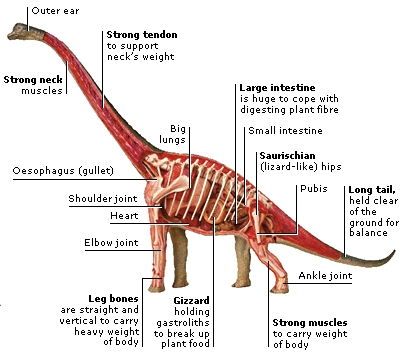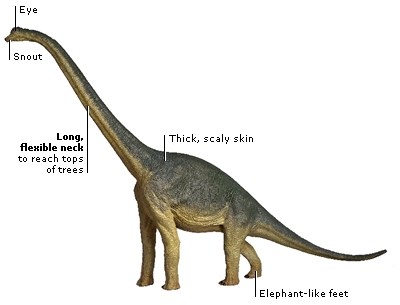DK Science: Long Necked Herbivores
The biggest land animals to have lived on Earth were the sauropods, which means “lizard feet”. These giants were the long-necked herbivorous (plant-eating) dinosaurs. They had small heads, long, flexible necks, bulky bodies, and long tails. They walked slowly on all fours and fed on conifers and other plants with tall stems. They existed for 130 million years, from the early Jurassic through to the late Cretaceous. Footprints show that they lived in herds or in family groups for protection against their cousins, the big carnivores.
An animal that eats plants rather than meat needs a complex digestive system to break down the food. Long-necked herbivores such as this Brachiosaurus could not chew, so they swallowed plant food whole and it was ground up in their stomachs. They also swallowed gastroliths (“stomach stones”), which churned with the plants in the stomach, breaking them into smaller, more easily digestible pieces.
The big digestive system of the long-necked herbivores had to be carried well forward of the lizard-like hips. This means that the animal could not have balanced on its hind legs only. Some of these dinosaurs, like this Brachiosaurus, had very long front legs, while others, such as Apatosaurus, did not. Their skin may have been elephantlike or possibly scaly. Some may also have had spines down their backs, for ornamentation and display.
Sauropods fed by raking and swallowing – they did not chew. And they would have had to keep eating all the time to feed their great bodies. The teeth of a Diplodocus were peg-like and arranged like the teeth of a rake at the front of the jaw. The teeth of a Camarasaurus were more spoon-shaped and filled most of the jaw. Both were adapted for pulling food off trees.
The wear on the narrow teeth of Diplodocus fossils reveals a lot about how the dinosaur fed itself and what it ate. The angle the skull was held at, the length of the neck, and the different types of wear on the teeth show that Diplodocus probably fed in two ways. It could reach up and eat from the tops of the trees for some of the time, but it could also reach around it on or near the ground for low-growing plants.
Some sauropods weighed as much as 100 tonnes – about the same as a blue whale. Their legs had to be strong enough to support this weight. They walked on their tiptoes, but under the parts of the toes that were lifted from the ground there was a wedge of gristle. This spread out the weight and took the pressure off the toes themselves. Elephants have this kind of a foot for exactly the same reason.
The earliest long-necked herbivores were the prosauropods, which means “before lizard feet”. Prosauropods evolved in the Late Triassic and died out in the Early Jurassic. They ranged from rabbit-sized lightweights that could scamper around on their hind legs, to lumbering elephant-sized animals that looked like the later sauropods. The earliest prosauropods were the ancestors of the sauropods.
To order this book direct from the publisher, visit DK's website.



